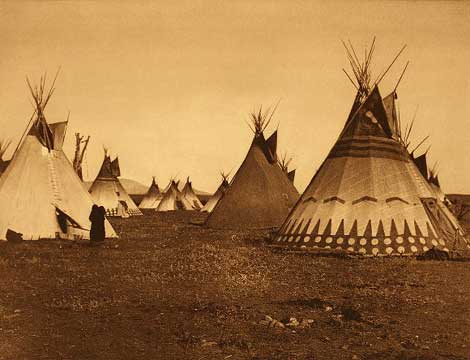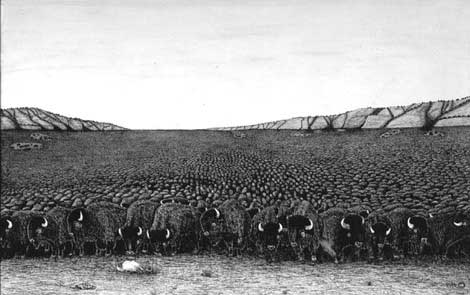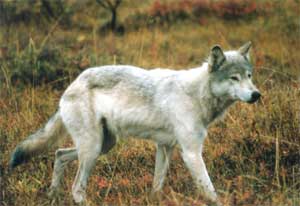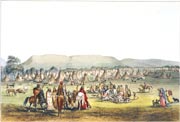|
Curly Bear Wagner
speaks about the
Canadian fur trade.
|
|
In October 1754 hundreds of Kainah, or Blood, people camped on
the Saskatchewan River, watched Anthony Henday and his Cree guides
enter their camp and walk through the esplanade created by 200
tipis, pitched in two long parallel rows.

|
Piegan camp, ca. 1900.
|
Edward Curtis image
Courtesy of Northwestern University Library.
|
Their horses, tethered to the lodges, would have whinnied as these
strangers walked among them. From the great lodge at the end of the
street, the chief and 20 elders waited for their visitors.
Inside the lodge the strangers were seated next to the chief. The pipe was passed
around in silence, then willow baskets full of boiled buffalo tongue were shared.
After these gracious formalities were completed, Henday told the men of his purpose
and invited the chief to send young men to Hudson's Bay to exchange their furs
for rifles, tobacco, blankets, ammunition, colored cloth, and beads.
The chief waited politely for the interpreter to complete his signing
of the message, then told the visitor how the Blackfeet were horsemen,
not accustomed to canoes; they ate meat, not fish; and they had heard
about Indians who starved while making their way to the trading posts.
These were serious problems, and besides, they had no need for the
goods Henday described. The buffalo provided all they could ever
want, and their bows and arrows were all they required to obtain
their prey.
"The inhabitants of the Plains are so advantageously situated
that they could live very happily independent of our assistance. They
are surrounded with innumerable herds of various kinds of animals, whose
flesh affords them excellent nourishment and whose skins defend them from
the inclemency of the weather, and they have invented so many means for
the destruction of animals that they stand in no need of ammunition to
provide a sufficiency for their purposes. It is then our luxuries that
attract them to the fort and make us so necessary to their happiness" (McGillivray:
1929).
[Duncan McGillivray, clerk for the North West Company, 1794.]

"The Herd," 1860—Martin S. Garretson.
Image courtesy of National
Museum of Wildlife Art.
The Blackfeet, in general, were not beaver trappers
with the exception of the westernmost bands of Piegan. The others
trapped kit foxes and wolves for furs. They were not interested in
completely changing their way of life to enter the trade as offered
by the Europeans.

Gray wolf
Image courtesy of Montana Department
of Fish, Wildlife, and Parks.
Accounts by whites in Blackfeet territory during the 18th century
paint a picture of friendly relationships. The traders who wintered
with various groups of Blackfeet were treated well, and commerce
was brisk. In 1805 the North West Company reported a typical acquisition
of 77,500 beaver, 51,250 muskrat, and 40,400 martin skins in addition
to 1,135 buffalo robes. Similar numbers were reported by the Hudson's
Bay Company. The Blackfeet participated by providing the bison robes
as well as horses for their transport. This business kept them focused
on controlling the buffalo plains and on stealing horses.
However, for a number of reasons, life couldn't continue this way
very long. The year that Lewis and Clark traveled up the Missouri,
the prolific trader David Thompson attempted to cross the Canadian
Rockies to explore the Columbia headwaters, but he was stopped by
the Piegans. As beaver were becoming scarce along the rivers of Hudson's
Bay, traders were sent into new areas, and Cree, Sioux, and Crow
were being pushed further westward into Blackfeet country, creating
new tension and conflict. Four years earlier, in 1801, "the Sakatow
man, the principal chief of the Piegans," complained to Thompson
about arming the Kootenays, whom the chief feared would arm the "Flat
Heads," and all this would cause harm to the Piegans. Any attempt
to establish trade relations with the Kutenai was seen as a direct
conflict with the Piegans.
It was this tense world that Lewis and Clark passed through in 1805. |









